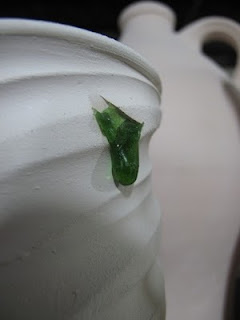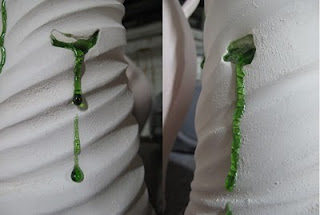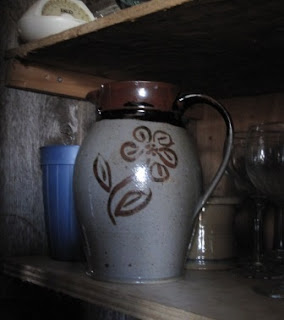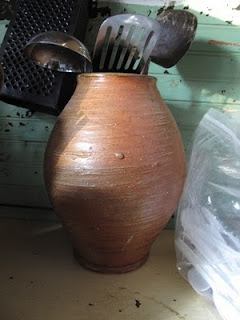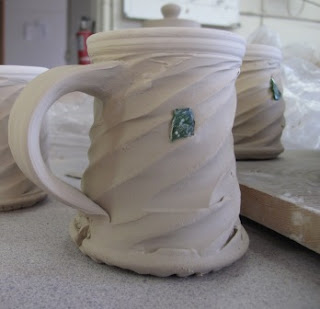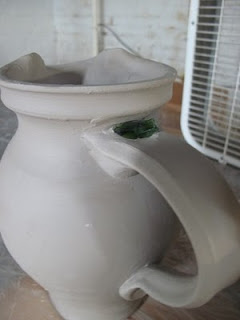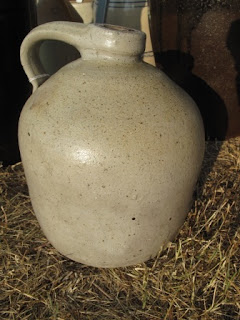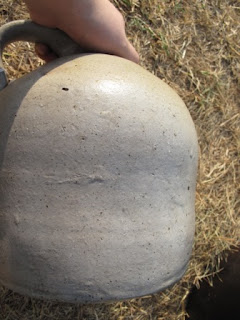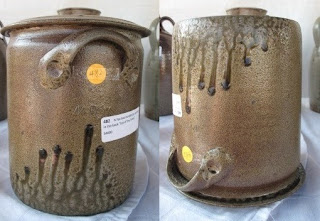In the past when people have asked me about bisquing ware with glass in it, I have told them confidently, "I have never had that happen." Even in my recent post, "Green Bottle Glass" I said, "The glass does not melt at all in the bisque, it anneals a little, but doesn't melt." Well, I withdraw my comments.
I knew there was something awry when I picked up a piece recently bisqued and saw this:
A large sagging drip of glass hung from the side of a mug. Then I looked at the other pieces. Some of the glass had not melted, but many of the pieces with glass in them looked like this:
I became more mesmerized by how beautiful the glass looked on top of the dry bisque body of the clay, and how fascinating it is to see the glass frozen, mid-melt. In all actuality, it is likely that these kilns are newer than many I have used before, and perhaps were operating a little hotter (I'll admit, I did not fire the bisque myself). I'm just going to cross my fingers that the glass does not get too frisky in the final firing!
So, perhaps I am not really eating my words, but chewing on what to say in the future!
Wednesday, October 27, 2010
Saturday, October 23, 2010
Visiting Old Friends
 |
| Lane Linnenkohl disking the field at Dry Branch Farm Photo by the author |
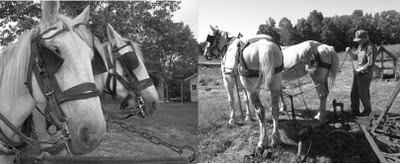 |
| Lane operates the farm on horse power, which I think is beautiful and admirable Photos by the author |
My pitchers have changed dramatically over the years, especially my handles. I found this pitcher in one of the cupboards at the farm. It is reduction-fired with a clear glaze and a painted decoration applied with the Tenmoku glaze which was also on the inside and on the rim. One thing I noticed the most about this pitcher is how thin the handle was, and how my handle terminal was not very strong.
This piece was a test piece for the salt kiln. I was working on textures and form, and while I enjoy what a thick slip of clay can do for the texture, I recall a comment about this piece being that the form needed work. I agree. It does make a nice utensil holder though!
This piece was hard to depart with. I was playing with testing various kinds of glass in the salt kiln, and the textures of handles. I thought the form was pretty nice, but the collar and neck needed some work. One of the critiques I remember receiving was that the piece looked incomplete, like it needed something. At the time, I didn't really see it, and now I do. It could use a lid, or the collar and neck could have been done in a different manner so as not to be so stark and straight-up.
Then there was the casserole. Anyone who was a part of the Ceramics Apprenticeship Program around 2007 remembers the bloating clay. It took a while to figure out what was going on, but in the end it was an impurity in one of our clays which we were mixing in the clay body we used for throwing. It didn't necessarily show up in the bisque firing, but definitely reared its ugly head during the glaze firing. This casserole had a few bloats on the outside, but I always enjoyed the glaze combination, and the knob on the top. It was my first run of making large casseroles, hollow knobs, and a ton of lidded objects! But it brings back the nightmares of losing entire kiln loads of pottery!
In closing, seeing these pieces again reminded me to always have a critical eye for my own work, and to step back and look at a piece in its entirety--- analyzing all of the components and how they work together.
Tuesday, October 12, 2010
Green Bottle Glass
Following my recent post a fellow former apprentice from Berea, Naomi Sellards, requested that I post some photos of what the green bottle glass looked like after it is fired. I put the chunks of green wine bottle glass on the pieces before they are bisqued. The glass does not melt at all in the bisque, it anneals a little, but doesn't melt. This also avoids applying the glass with glaze (post-bisque) and crossing your fingers that the glass stays on the piece during the firing. From experience, I will say that I don't recommend doing this unless you are putting it on top of a handle or horizontal surface. Otherwise, the glaze, which you thought would hold the glass on, fluxes before the glass fluxes in the final firing and drops the glass (or so it would seem, I could be wrong as to what exactly it does in there). Also, putting the glass in it when the ware is green leaves a neat impression on the piece after the glass melts in the final kiln.
As I mentioned in the previous blog, I'm a devotee of green wine bottle glass. I have tried other kinds of glass. I did some experimenting with this when I was at Berea. I don't have any photos of what happpened with the brown bottle glass, but it basically would leave these nasty pink crizzled streaks on the piece. I think there was either an impurity in the brown glass, or it just didn't like salt.
 |
| Nice collection of melted glass in the texture of the mug |
 |
| A little crystallizing! |
I don't put large chunks on because depending on where it is in a wood kiln, the glass can get really out of control! Either way, I really like how the glass pools on the textured surface of the newer pieces I have been making. I'm willing to do some grinding if I have to. I've heard other potters such as Mark Hewitt use pure glass pieces, or frit, for their glass source. Some people I've talked to have used beads from a craft store. My experience with beads from a craft store was not good (especially blue beads) as the surface crizzled and didn't look good. I think it must have something to do with the level of purity that the glass is. I could be completely wrong, and if any of you know better than I, please do let me know! In the meantime, I'll stick with green wine bottle glass.
I have quite a few pieces with glass in them (hopefully) going in a kiln in the next month. I'll be sure to post photos of their outcome!
Monday, October 11, 2010
One Hundred Pounds of Productivity
For the past two afternoons I have had the opportunity to throw pottery, uninterrupted, with productive results! This was the weekend for bigger items and trying to finish a few orders. It's been a while since I've thrown about 100 pounds in a few days, but I'm not in any pain (thankfully, and I know I shouldn't have any pain if I throw correctly, but I figured my muscles which have not been used as much would be complaining)! My favorite thing to throw are bottles, and it was great to get back in the groove of making bottles. I love the shapes, and I received a request for an eighteenth-century style bottle, which I have a photo of here:
 |
| I went for an English style, mostly London-based. I think the handles are pretty good, but something to work on more. |
I also tried out a new rim style. I have been making my rims and lips of pitchers similar to this for a few years:
 |
| I'd been using a rib tool to make indentations on the side of the lip |
But I have been wanting a little more flare, and a little more rise around the lip, so I tried this:
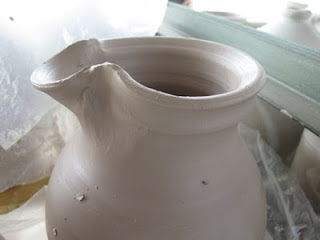 |
| I left more clay at the rim and then pulled the edges of the lip up to get that rise |
I've also had a request for one liter tankards. I never quite wrapped my head around how big that was, until I realized my Nalgene holds one liter. They're really big! So, tankards have taken over several shelves of my ware rack:
 |
| Tankard Fest 2010 |
The finishing touches were to put glass on some of the mugs and vases I threw, as well as on a few of the pitcher handles:
Wednesday, October 6, 2010
Antiquing with a Potter Part 1
My small, lovely town of Liberty, North Carolina has an enormous antiques festival twice a year. This was my first time going, and of course, I spent most of my time admiring and fondling pottery (it's a habit). So I thought I would share with you some of my adventures and things that I focus on when I am analyzing a piece of pottery.
I have recently received a research grant from the American Ceramic Circle in order to analyze kiln furniture and kiln designs of pre-1850 American stoneware pottery sites. Part of that research will (hopefully and eventually) be comparing intact pieces from known kiln sites to the kiln furniture used at those sites. Something I am always fascinated by is telling how a pot was fired from the marks left by the kiln furniture used, and sometimes by the kiln itself. There was no shortage of pottery to be seen! I have the tendency to be attracted to the somewhat disheveled and "worse for the wear" pieces such as this bottle:
I know, you're probably thinking, "what in the world is so attractive about that?!" Well, there are numerous aspects, really. This likely 19th or early 20th century salt-glazed stoneware bottle had a great handle for starters. Then, it had such great distinctions for how it was fired. Look at how the neck is cocked to one side, and then in the photo below at the narrowing on the sides. This tells me that this piece was single fired, and shows these deformations because of the weight and stress of stacking (no shelves used) and the movement of the clay body as it came to temperature during the firing.
And the top of the bottle also showed some great signs of firing:
Then there's an occasional really exciting piece, such as the early 19th century Nicholas Fox piece which was pictured in The Potter's Eye (page 93). What I love the most about antique shows, auctions, etc., is that you can HANDLE the objects, and feel the weight of them, the texture, and flip them over. The Fox piece was beautifully photographed in the book, but I thought it would be fun to let you see how it was fired:
UPSIDE DOWN! You can see the wonderful dripping action on the side of the piece, and the pooling of ash on the underside of the handles and rim. Below, you can see how the piece was also likely at the top of the kiln, or between other objects, as it had nothing placed on its base, leaving a beautiful textured surface. You can also see in the photo on the left (below) a likely small chunk of kiln debris which has been there for almost 200 years!
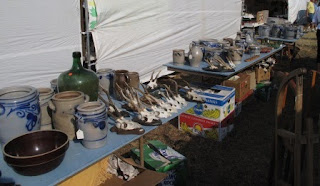 |
| This fascinating array of objects were nearly all from the Westerwald region of Germany, it was such a pretty sight to see! |
I know, you're probably thinking, "what in the world is so attractive about that?!" Well, there are numerous aspects, really. This likely 19th or early 20th century salt-glazed stoneware bottle had a great handle for starters. Then, it had such great distinctions for how it was fired. Look at how the neck is cocked to one side, and then in the photo below at the narrowing on the sides. This tells me that this piece was single fired, and shows these deformations because of the weight and stress of stacking (no shelves used) and the movement of the clay body as it came to temperature during the firing.
And the top of the bottle also showed some great signs of firing:
 |
| This bottle's collar likely covered the rim of the bottle judging from the mark in the left photo, and also touched on the shoulder of the bottle as seen by the marks in the photo on the right |
UPSIDE DOWN! You can see the wonderful dripping action on the side of the piece, and the pooling of ash on the underside of the handles and rim. Below, you can see how the piece was also likely at the top of the kiln, or between other objects, as it had nothing placed on its base, leaving a beautiful textured surface. You can also see in the photo on the left (below) a likely small chunk of kiln debris which has been there for almost 200 years!
Subscribe to:
Posts (Atom)

